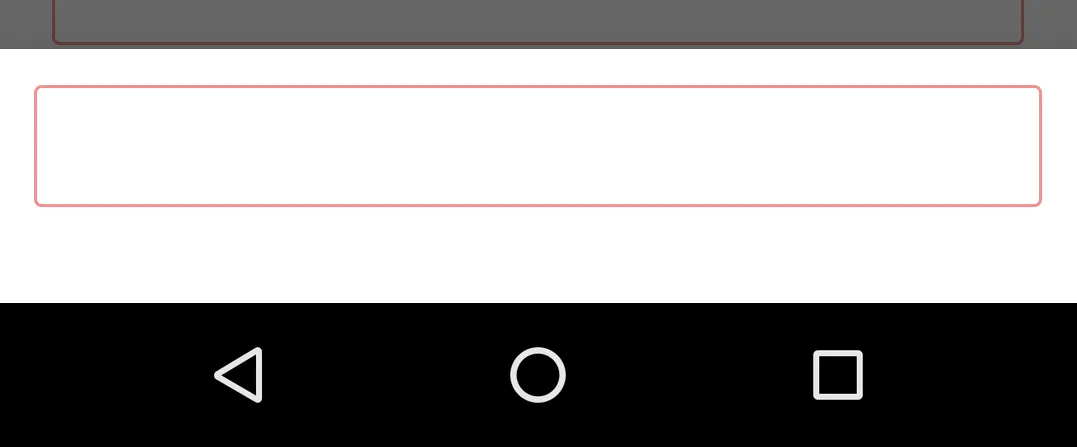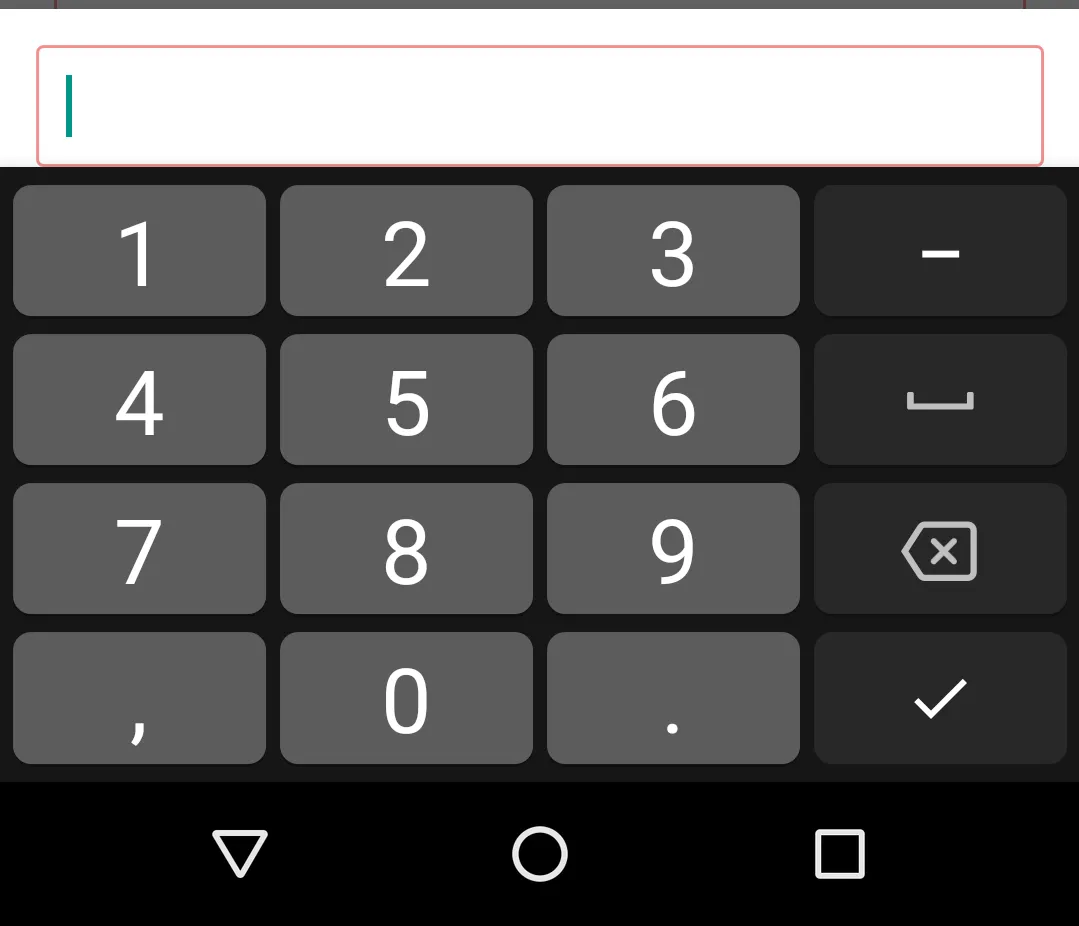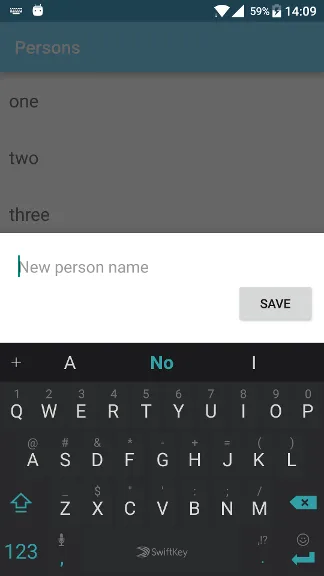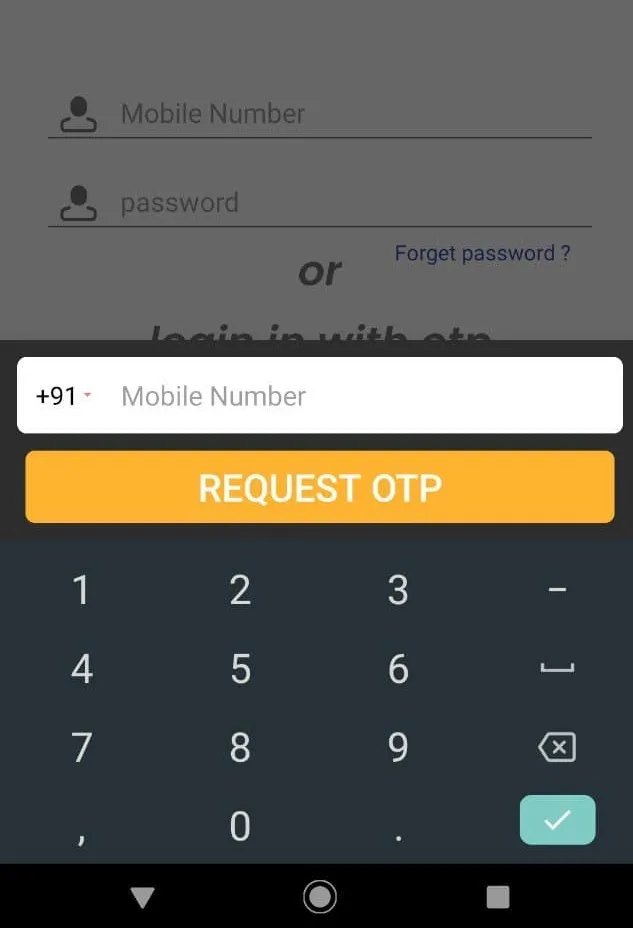显示带有EditText的完整底部表单,位于键盘上方。
7
只是转载了@jblejder的问题,链接为Keyboard hides BottomSheetDialogFragment,因为它对我有效,以便让其他人更容易找到:
我发现最方便的方法是创建样式来更改此设置:
<style name="DialogStyle" parent="Theme.Design.Light.BottomSheetDialog">
<item name="android:windowIsFloating">false</item>
<item name="android:statusBarColor">@android:color/transparent</item>
<item name="android:windowSoftInputMode">adjustResize</item>
</style>
将以下代码设置在BottomSheetDialogFragment的onCreate方法中:
override fun onCreate(savedInstanceState: Bundle?) {
super.onCreate(savedInstanceState)
setStyle(DialogFragment.STYLE_NORMAL, R.style.DialogStyle)
}
这是在我的设备上的样子:
==== 更新 ====
正如评论中已经多次提到的那样,您可能还需要将BottomSheetDialog的状态设置为STATE_EXPANDED,就像下面Nordknight的答案一样。
dialog = new BottomSheetDialog(getContext(), R.style.BottomSheetDialog);
dialog.setOnShowListener(new DialogInterface.OnShowListener() {
@Override
public void onShow(DialogInterface dialog) {
new Handler().postDelayed(new Runnable() {
@Override
public void run() {
BottomSheetDialog d = (BottomSheetDialog) dialog;
FrameLayout bottomSheet = d.findViewById(R.id.design_bottom_sheet);
BottomSheetBehavior bottomSheetBehavior = BottomSheetBehavior.from(bottomSheet);
bottomSheetBehavior.setState(BottomSheetBehavior.STATE_EXPANDED);
}
},0);
}
});
9
EditText上方,所以EditText被提起并允许输入,但不能按下下面的“按钮”。应用了你的解决方法后,什么都没有改变。 - CoolMindoverride fun onCreateDialog(savedInstanceState: Bundle?): Dialog {
val bottomSheetDialog = super.onCreateDialog(savedInstanceState)
if (bottomSheetDialog is BottomSheetDialog) {
bottomSheetDialog.behavior.skipCollapsed = true
bottomSheetDialog.behavior.state = BottomSheetBehavior.STATE_EXPANDED
}
return bottomSheetDialog
} - Prasad MhapankarBottomSheetDialogFragment,唯一的方法是将属性android:windowIsFloating启用为true。这将使整个窗口位于试图占据其后面空间的任何内容之上。<style name="BottomSheetDialogThemeNoFloating" parent="Theme.Design.Light.BottomSheetDialog">
<item name="android:windowIsFloating">false</item>
<item name="android:windowSoftInputMode">adjustResize|stateVisible</item>
</style>
然后在您对话框的onCreate()中,设置此样式。
override fun onCreate(savedInstanceState: Bundle?) {
super.onCreate(savedInstanceState)
// set the window no floating style
setStyle(DialogFragment.STYLE_NORMAL, R.style.AppRoundedBottomSheetDialogThemeNoFloating)
}
对于那些经常使用底部表格并可能希望处理EditText和软键盘重叠的人来说,这非常方便。
注意:mikepenz的KeyboardUtil类在某些手机上存在问题,即使为提供的整个内容视图提供了底部填充,输入字段的内容视图仍会自动推到键盘上方。
4
BottomSheetDialogFragment时,这对我很有效。 - Sagar Patel<item name="android:windowIsFloating">false</item>。到底应该选哪一个? - mathematics-and-caffeinedialog = new BottomSheetDialog(getContext(), R.style.BottomSheetDialog);
dialog.setOnShowListener(new DialogInterface.OnShowListener() {
@Override
public void onShow(DialogInterface dialog) {
new Handler().postDelayed(new Runnable() {
@Override
public void run() {
BottomSheetDialog d = (BottomSheetDialog) dialog;
FrameLayout bottomSheet = d.findViewById(R.id.design_bottom_sheet);
BottomSheetBehavior bottomSheetBehavior = BottomSheetBehavior.from(bottomSheet);
bottomSheetBehavior.setState(BottomSheetBehavior.STATE_EXPANDED);
}
},0);
}
});
这段代码在Fragment的onCreateView方法中运行良好(感谢ADM)
1
希望这能帮助到某些人。
BottomSheetDialog(this, R.style.DialogStyle).apply {
setContentView(layoutInflater.inflate(R.layout.bottom_sheet, null))
window?.setSoftInputMode(WindowManager.LayoutParams.SOFT_INPUT_STATE_ALWAYS_VISIBLE)
findViewById<EditText>(R.id.time_et)?.requestFocus()
show()
}
layout/bottom_sheet.xml
<?xml version="1.0" encoding="utf-8"?>
<ScrollView xmlns:android="http://schemas.android.com/apk/res/android"
xmlns:app="http://schemas.android.com/apk/res-auto"
android:layout_width="match_parent"
android:layout_height="wrap_content"
android:background="#ffffff"
android:padding="16dp">
<LinearLayout
android:layout_width="match_parent"
android:layout_height="wrap_content"
android:orientation="vertical">
<LinearLayout
android:layout_width="match_parent"
android:layout_height="wrap_content"
android:orientation="horizontal">
<View
android:layout_width="0dp"
android:layout_height="match_parent"
android:layout_weight="1" />
<LinearLayout
android:layout_width="0dp"
android:layout_height="wrap_content"
android:layout_weight="5"
android:orientation="vertical">
<TextView
android:layout_width="wrap_content"
android:layout_height="wrap_content"
android:text="Time"
android:textColor="#000000"
android:textSize="24sp"
android:textStyle="bold" />
<LinearLayout
android:layout_width="wrap_content"
android:layout_height="wrap_content"
android:layout_marginTop="8dp"
android:orientation="horizontal">
<EditText
android:id="@+id/time_et"
android:layout_width="wrap_content"
android:layout_height="wrap_content"
android:inputType="numberSigned"
android:minWidth="50dp"
android:text="15" />
<TextView
android:layout_width="wrap_content"
android:layout_height="wrap_content"
android:layout_marginLeft="8dp"
android:text="min" />
</LinearLayout>
</LinearLayout>
</LinearLayout>
<Button
android:layout_width="match_parent"
android:layout_height="wrap_content"
android:layout_marginTop="16dp"
android:background="#000"
android:text="Save"
android:textColor="#fff" />
</LinearLayout>
</ScrollView>
styles.xml(针对使用statusBarColor的v-21进行拆分)
<style name="DialogStyle" parent="Theme.MaterialComponents.Light.BottomSheetDialog">
<item name="android:windowIsFloating">false</item>
<item name="android:statusBarColor">@android:color/transparent</item>
<item name="android:windowSoftInputMode">adjustResize</item>
</style>
2
windowSoftInputMode,特别是对于BottomSheetDialogFragment,这对我起到了作用。<item name="android:windowSoftInputMode">adjustResize</item> - isles1217 private fun enterMobileNumberPopUp() {
val dialog = BottomSheetDialog(this,R.style.DialogStyle)
val view = layoutInflater.inflate(R.layout.layout_otp, null)
dialog.setContentView(view)
dialog.behavior.state = BottomSheetBehavior.STATE_EXPANDED
dialog.show()}
<style name="DialogStyle" parent="Theme.Design.Light.BottomSheetDialog">
<item name="android:windowIsFloating">false</item>
<item name="android:statusBarColor">@android:color/transparent</item>
<item name="android:windowSoftInputMode">adjustResize</item>
样式参考
对于此类情况,可以使用 BottomSheetDialog。它会在软键盘打开时打开,并将焦点放在编辑文本上。但是用户仍然可以关闭软键盘,而对话框将被重置为底部。再次聚焦将使对话框出现在软键盘顶部。
public void showDialog() {
final BottomSheetDialog dialog=new BottomSheetDialog(this);
dialog.setContentView(R.layout.item_dialog);
dialog.getWindow().setSoftInputMode(WindowManager.LayoutParams.SOFT_INPUT_STATE_ALWAYS_VISIBLE);
dialog.show();
}
你可以使BottomSheetDialog在键盘上方展开。但是为此,你需要在软键盘打开后调用它。展开的代码是:
BottomSheetDialog d = (BottomSheetDialog) dialog;
FrameLayout bottomSheet = (FrameLayout) d.findViewById(android.support.design.R.id.design_bottom_sheet);
BottomSheetBehavior.from(bottomSheet).setState(BottomSheetBehavior.STATE_EXPANDED);
我已经在DialogInterface.OnShowListener()上进行了测试,但它没有起作用。通过1秒的延迟测试,它可以工作。但延迟不是解决方案。您需要找出应该在哪个操作上扩展对话框。
final BottomSheetDialog dialog=new BottomSheetDialog(this);
dialog.setContentView(R.layout.item_dialog);
dialog.getWindow().setSoftInputMode(
WindowManager.LayoutParams.SOFT_INPUT_ADJUST_RESIZE|
WindowManager.LayoutParams.SOFT_INPUT_STATE_ALWAYS_VISIBLE);
new Handler().postDelayed(new Runnable() {
@Override
public void run() {
FrameLayout bottomSheet = (FrameLayout) dialog.findViewById(android.support.design.R.id.design_bottom_sheet);
BottomSheetBehavior.from(bottomSheet).setState(BottomSheetBehavior.STATE_EXPANDED);
}
},2000);
dialog.show();
7
BottomSheetDialog,但它仍然覆盖了 EditText 下面的底部区域。 - adviceBottomSheetDialog,这样我就可以在EditText下方放置其他内容并且仍然能够看到它们。 - advicehandler.postDelay()测试过了,它可以正常工作。不过试一下查看BottomSheetFragment,也许它能满足你的需求。 - ADMhandler.postDelayed(),并且在此之前我也使用了 BottomSheetFragment,但似乎问题依旧存在。 - advice bottomSheetDialog.getWindow().setSoftInputMode(WindowManager.LayoutParams.SOFT_INPUT_ADJUST_RESIZE);
一定能够正常工作。
2
在您的主 AppTheme 样式中,您可以添加属性 bottomSheetDialogTheme,将样式应用于所有 BottomSheetDialogFragments:
<style name="AppTheme" parent="Theme.MaterialComponents.Light.DarkActionBar">
<item name="colorPrimary">@color/primary</item>
<item name="colorPrimaryDark">@color/primary_dark</item>
<item name="colorAccent">@color/accent</item>
<item name="bottomSheetDialogTheme">@style/BottomSheetDialogStyle</item>
</style>
因此,不需要在您的BottomSheetDialogFragment代码中添加任何内容。
然后,就像以前的回答一样,您的对话框样式需要与Material Components库相匹配(否则会得到一些外观奇怪的按钮、编辑框等):
<style name="BottomSheetDialogStyle" parent="Theme.MaterialComponents.Light.BottomSheetDialog">
<item name="android:windowIsFloating">false</item>
<item name="android:windowSoftInputMode">adjustResize</item>
<item name="android:statusBarColor">@android:color/transparent</item>
<item name="colorPrimary">@color/primary</item>
<item name="colorPrimaryDark">@color/primary_dark</item>
<item name="colorAccent">@color/accent</item>
</style>
请注意,我在这里添加了我的应用程序主题颜色;由于Android样式中不能多重继承,您可能希望在此定义这些颜色,以便任何按钮和强调与您的应用程序的其余部分保持一致。
如果您正在使用底部表单片段,覆盖getTheme().setStyle对我来说没有起作用。请将整个布局包装在NestedScrollView中。
themes.xml
<style name="BottomSheetDialogStyle" parent="Theme.Design.BottomSheetDialog">
<item name="android:windowBackground">@null</item>
<item name="android:windowIsFloating">false</item>
<item name="android:statusBarColor">@android:color/transparent</item>
<item name="bottomSheetStyle">@style/bottomSheetBackground</item>
<item name="android:windowSoftInputMode">adjustResize|stateVisible</item>
</style>
底部弹出式片段
@Override
public int getTheme() {
return R.style.BottomSheetDialogStyle;
}
override fun setupDialog(dialog: Dialog, style: Int) {
super.setupDialog(dialog, style)
dialog.window?.setSoftInputMode( WindowManager.LayoutParams.SOFT_INPUT_STATE_ALWAYS_VISIBLE or
WindowManager.LayoutParams.SOFT_INPUT_ADJUST_RESIZE
);
}
原文链接



